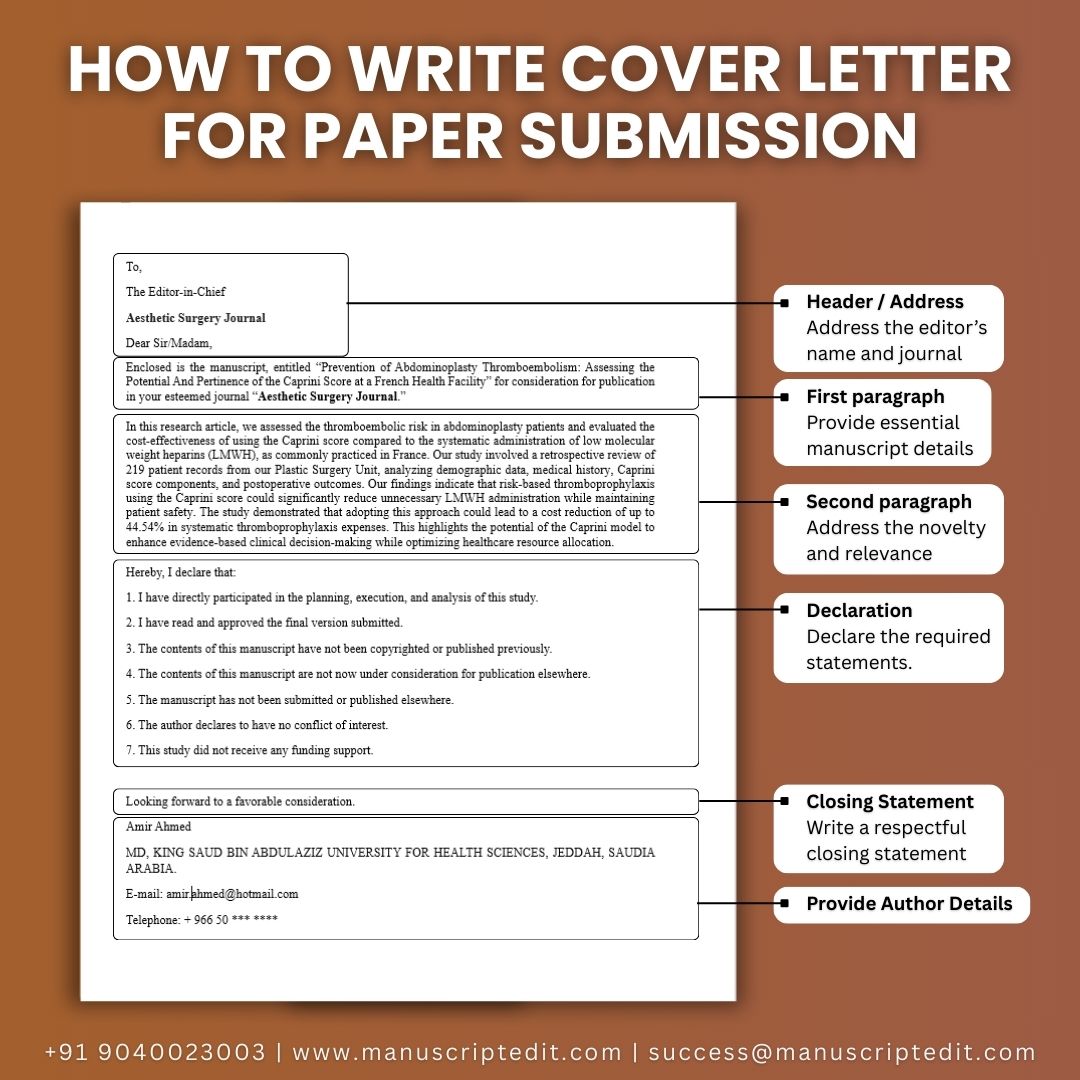|
Getting your Trinity Audio player ready...
|
You’ve finished your research, edited your paper, and picked a journal. But wait—don’t submit it just yet. One important step is left: the journal cover letter.
A strong cover letter isn’t just a formality—it helps show why your work is important and a good fit for the journal. A weak or generic one could get your paper rejected, even if the research is solid.

This step-by-step guide will show you what to write, how to format it, and what to avoid. We’ve also added a sample letter and a free template to help you get started.
Table of Contents
1. What Is a Journal Cover Letter and Why It Matters
A journal cover letter is a short letter you send with your manuscript. It introduces your research, explains why it matters, and why it fits the journal.
Why It’s Important:
- First impression – Editors may decide whether to review your paper based on this letter.
- Shows novelty – Explains what’s new and useful in your work.
- Proves journal fit – Connects your research to the journal’s focus.
- Includes required info – Like stating the paper isn’t submitted elsewhere.
2. What to Include in a Journal Cover Letter
Keep it short—no more than one page. Make sure to include:
- Manuscript title and journal name
- Short background and the research gap
- Key findings and their importance
- Why it fits the journal
- Ethical statements (e.g. not submitted elsewhere, all authors agree)
- Your contact info and a polite closing
3. Journal Cover Letter Format: The Right Structure
Header (Your Info)
- Your name, institution, email, and the date
- The editor’s name (if known) or just “Dear Editor,”
Opening Paragraph
- Clearly say why you’re writing:
“We are pleased to submit our manuscript, [Title], for consideration in [Journal Name].”
Body (2–3 Short Paragraphs)
- What your research is about and why it matters
- The main results and what they show
- Why it fits the journal
Closing Paragraph
- Ethical statements (not under review elsewhere, all authors approve)
- Thank the editor for their time
Signature
- “Sincerely,”
- Your name, degree, and institution
4. How to Address the Editor
- If you know their name: “Dear Dr. Smith,”
- If you don’t: “Dear Editor,” or “Dear Editor-in-Chief,”
- Don’t use: “To whom it may concern” (too impersonal)
5. How to Customize the Letter for the Journal
- Check the journal’s Aims & Scope on their website
- Mention papers recently published there
- Say why the journal’s readers would care about your research
Example:
“Our findings on [topic] match your journal’s focus on [area], as seen in a recent article by [Author et al., Year].”
6. Sample Journal Cover Letter (For First-Time Authors)
[Your Name]
[Your Institution]
[Email] | [Date]
Dear Dr. [Editor’s Last Name],
We are pleased to submit our manuscript, “[Title]”, for consideration in [Journal Name]. Our study investigates [research question], addressing a critical gap in [field].
We found that [key result], which could impact [area or application]. This work fits your journal’s focus on [topic], as shown in [recent publication or theme].
This manuscript is original, not under review elsewhere, and all authors approve its submission. Thank you for your time and consideration.
Sincerely,
[Your Name], [PhD/MD/etc.]
[Your Institution]
7. Common Mistakes to Avoid
- Too long or unclear → Keep it short and focused
- Not customized → Show why your paper fits the journal
- Overstating your findings → Be honest and accurate
- Skipping ethical statements → Always confirm originality and author consent
- Repeating the abstract → Summarize briefly; don’t copy your abstract
8. Do All Journals Need a Cover Letter?
- Most journals do, but some (like PLOS ONE) may not
- Always check the journal’s submission rules

Final Tips
- Check spelling and grammar – Mistakes can hurt your credibility
- Follow journal rules – Some have specific requirements
- Be professional but clear – Editors read many letters; make yours easy to follow
Want Help With Your Cover Letter?
[Get a Custom Journal Cover Letter from Our Experts]
By following this guide, you’ll write a strong journal cover letter that gives your paper the best chance of being accepted.
No matter whether you require a polished, journal-specific cover letter or assistance in writing point-by-point responses to peer reviewers, our seasoned editors can support you every step of the way. We guarantee your message is professional, persuasive, and journal-compliant.
Our Services Include:
- Professionally written cover letters tailored to your target journal
- Clear, respectful, and persuasive reviewer response letters
- Language editing for tone, grammar, and clarity
- Formatting based on journal-specific submission guidelines
Avoid holding up your publication with weak communication. Allow us to help you make a strong first impression.
Receive Expert Assistance with Your Cover Letter or Reviewer Response.



